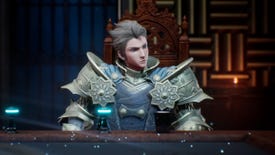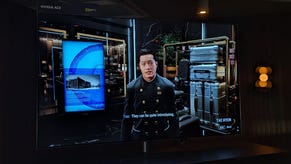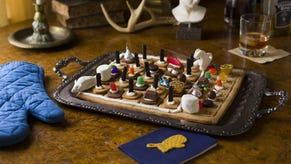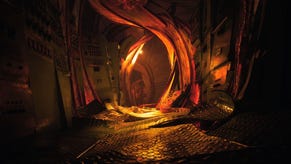The DioField Chronicle is shaping up to be real-time Fire Emblem meets Final Fantasy
Now that’s my kind of combo
Square Enix have made a vast array of RPGs over the years, but rarely have they ventured into the realm tactics and strategy games. A couple of big names come to mind, the obvious one being Final Fantasy Tactics, Tactics Ogre if you count their PSP remake of Quest's SNES original, and most recently, Triangle Strategy on the Switch. Outside of that, though, it's all a bit barren, which is why the real-time tactical sword-swinging of their upcoming strategy RPG The DioField Chronicle is such an interesting landgrab for them. To say they're pushing into new territory would be an understatement.
Happily, judging by the sizable first chapter of the game (currently available to play for free on Steam until the game's release on September 22nd), it's clear that Square Enix and their development partners at Lancarse have a lot of smart decisions here. With its focus on individual hero characters instead of nameless military units, mixed in with the magical pizazz and flashy summons of its Final Fantasy games, The DioField Chronicle could just be the Fire Emblem-shaped hole PC players have been looking for.
The real-time nature of its top-down diorama battles naturally gives The DioField Chronicle a slightly different rhythm to the long, drawn-out turns of recent Fire Emblem games, but when you're constantly pausing the action to direct your units where to move, attack and which special moves you'd like to deploy, its similarities go further than you might think. The closest comparison is probably Final Fantasy VII Remake, which blended real-time and turn-based scraps with surprising style, giving players plenty of time to think and make decisions while keeping the pace of battle riding high.
So it is here in The DioField Chronicle. In classic RTS style, you can drag and drop your mouse to select all four units at once, or you can click them individually to relay specific orders. The action is paused while you're doing this, the screen entering a dull monotone to help differentiate its 'tactical pause' from the main action. In this mode, you can also see enemy sight circles, the range of explosive barrels, and other handy environmental cues you might want to consider taking advantage of as you push up through its largely linear play spaces.
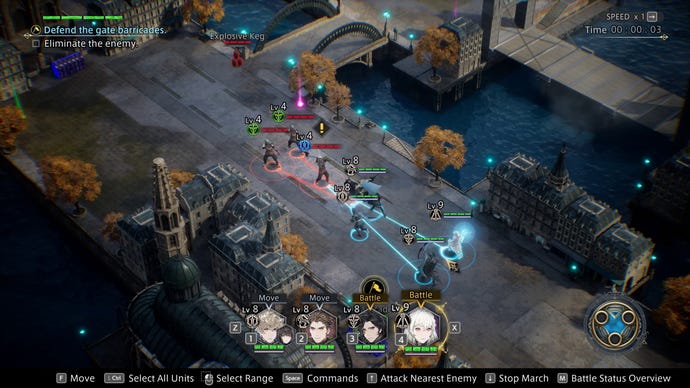
Not all enemies are displayed at once, though, with many more beaming in mid-mission as you reach checkpoints or capture outposts. For the most part, I found this helped to keep battles feeling fresh, as it meant you couldn't easily predict how they'd shakeout as you progressed. That said, there were still a few rug-pull moments here and there which, if I'd known were coming, I might not have wasted my big Bahamut summon on, for example, or I might have made more of an effort to collet some the leftover HP and ability point crystals scattered around the battlefield. Still, these moments were few and far between in the three hours I spent playing this opening chapter, and I felt better able to react on the fly as opposed to dreading the onslaught yet to happen.

It helps that battles are short and sharp, too. Most are over in five or six minutes, with some missions even rewarding you with extra gold for getting things done and dusted quickly in a particular time limit. The extra end-of-mission goodies don't stop there, either. You can also earn extra skill points to unlock abilities or improve existing ones in its intimidatingly large skill tree by making sure none of your heroes fall in battle, and you can also nab extra treasures by stopping to open treasure chests.
Most missions have mini-objectives along this kind of line, but that doesn't mean you're constantly replaying the same kind of five-minute battles again and again. Sure, The DioField Chronicle's opening chapter does some pretty heavy tutorialising in its first clutch of missions, giving them a natural sense of variety as it introduces all of its various concepts, but within those first few hours, I'd done your classic 'eliminate every enemy on the map' type mission, defended a manor house from the undead, captured turret towers to unlock drawbridges and open up new areas of a map, escorted a carriage through a dangerous mountain path, and fought three boss characters.

Admittedly, the bosses might be the weakest part of The DioField Chronicle, as they're essentially just massive HP sponges, simply requiring you to hack away at multiple health bars until they're dead. In their defence, they do have slightly more flamboyant attacks than your run of the mill infantry goons, but when their areas of effect are clearly telegraphed with big red danger zones that become increasingly angry-looking the closer it is to being enacted, simply moving your warriors out of the way or stunning them with a shield bash attack (as you would with every other enemy type with an AOE attack) is about as 'tactical' as these encounters get.
That's not to say positioning is completely unimportant, though. Generating aggro so some of your warriors can attack from behind in deadly 'ambush' attacks is vital to dealing damage quickly, as is managing your characters' special abilities over the course of a mission. These can range from similarly devastating AOE attacks to individual sword dances, but others with status effects can make for some particularly powerful combos to help you manipulate the flow of battle. Frederet, my big knight on a horse, for example, has a big frontal assault charge, which not only hits multiple enemies in a big straight line, but it also knocks them back into a nice, bunched up group, leaving them open for my archer Iscarion to lay down some concentrated covering fire in the area they'll be using to race back toward the rest of my squad. I know they'll be running this way, too, as my swordsman Andrias has just put up his taunting shield barrier. The final touch is often a big fiery meteor spell from my healer mage Waltaquin, setting the ground alight as they continue running blindly forwards.

However, each character only has so many EP points to dole out these kinds of attacks, so another part of The DioField Chronicle's strategic layer is knowing when to bring out the big guns, so to speak. Items can used to top up characters' EP bars mid-battle, but money to buy new ones is reasonably scarce on this war-torn island (even with completing the gold-boosting mini objectives), especially when you also need to balance those funds with upgrading your warriors' weapons, armour and stat-boosting accessories and upgrading your various merchant stalls back at your mercenary HQ.

As such, you'll want to make sure a character's EP bar lasts the entire length of a mission, so you'll need to balance them out with their regular auto-attacks. It's actually very Xenoblade-like in some respects, as each skill also has its own cooldown timer before it can be used again. It's probably a big reason why I like it so much, although even I'm willing to admit that this hero-led style of RTS battling will likely prove divisive among traditional strategy fans.
Indeed, at first I felt like I was sailing through battles, and that this seeming over-reliance on big flashy abilities would make The DioField Chronicle feel too easy; that, really, it was more of an action RPG than a proper strategy game. But as that first chapter wore on, the combination of tougher enemies and those limited funds for only a couple of choice equipment upgrades meant I definitely started to feel the limits of my characters' EP bars by the time missions were drawing to a close. Similarly, a couple of missions required me to split up my unit of four as threats poured in from different areas of the map all at once, and making sure they were positioned correctly while not biting the dust in the process was thrilling, heart-pumping stuff that put me in the chokepoint juggling mindset of my recent foray into Company Of Heroes 2.

The DioField Chronicle is a simpler kind of RTS, no doubt about it, but it's also one that feels energised by its bite-sized missions and wonderfully animated screen-hogging abilities. Heck, I was even mildly intrigued by what's left to uncover in the still partially closed off rooms of the Blue Fox's manor-like HQ, which you can wander around between missions like the big school in Fire Emblem: Three Houses. Alas, there aren't any students or other mercenaries to bat your eyelashes at (although there are character quests to further their individual stories), but the way you can upgrade its various rooms to get better stuff does have a faint whiff of XCOM about it, and I liked being able to walk around speaking to my fellow squad mates, finding new sidequests and turning this repurposed stately home into a proper base of operations.
As a place, it's certainly more artificial feeling than the Three Houses academy (seriously, who puts up iron gate railings inside their house to stop people going up the stairs?), and yes, there were parts of its story about warring clans fighting over ancient, precious resources that felt like reheated leftovers of a discarded Final Fantasy plot. But its central protagonists made for a winning quartet as RPG parties go, and its mix of aristocratic subterfuge, ancient sorcery and Final Fantasy-style summons has me itching to stick around its halls just a little longer to find out more. I would love to have more Square Enix strategy epics on PC, so here's hoping the full game doesn't disappoint when it comes out on September 22nd.



